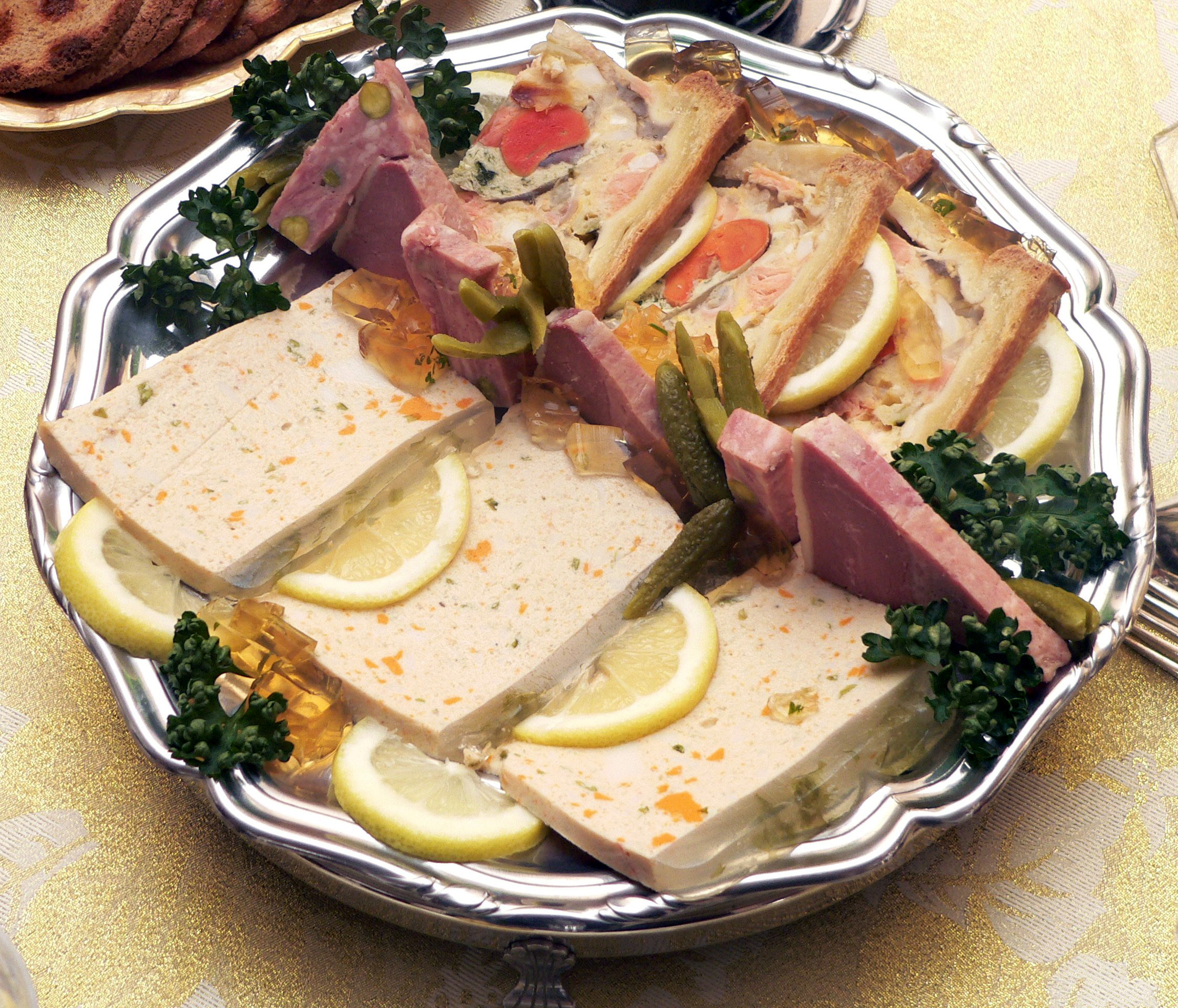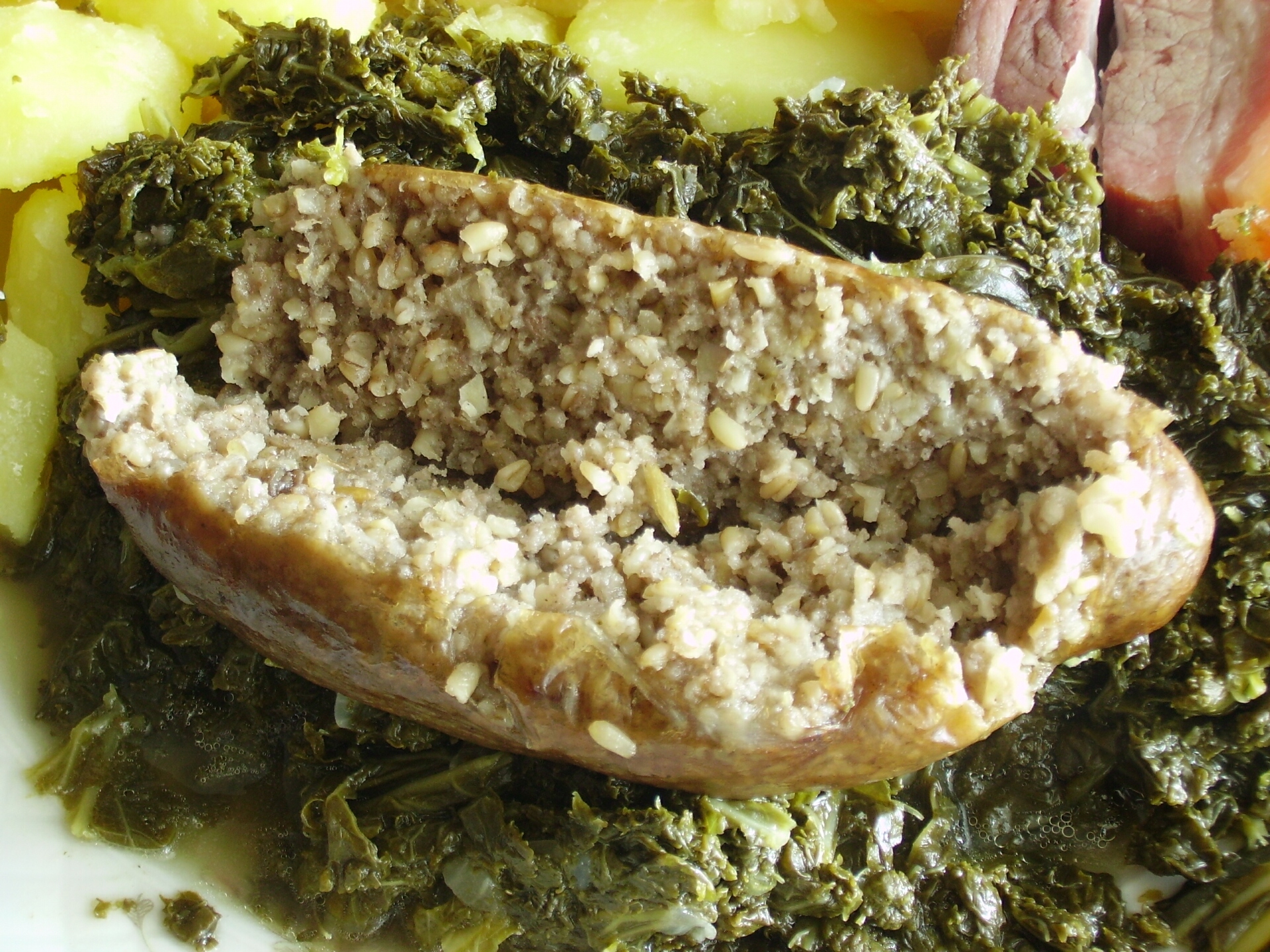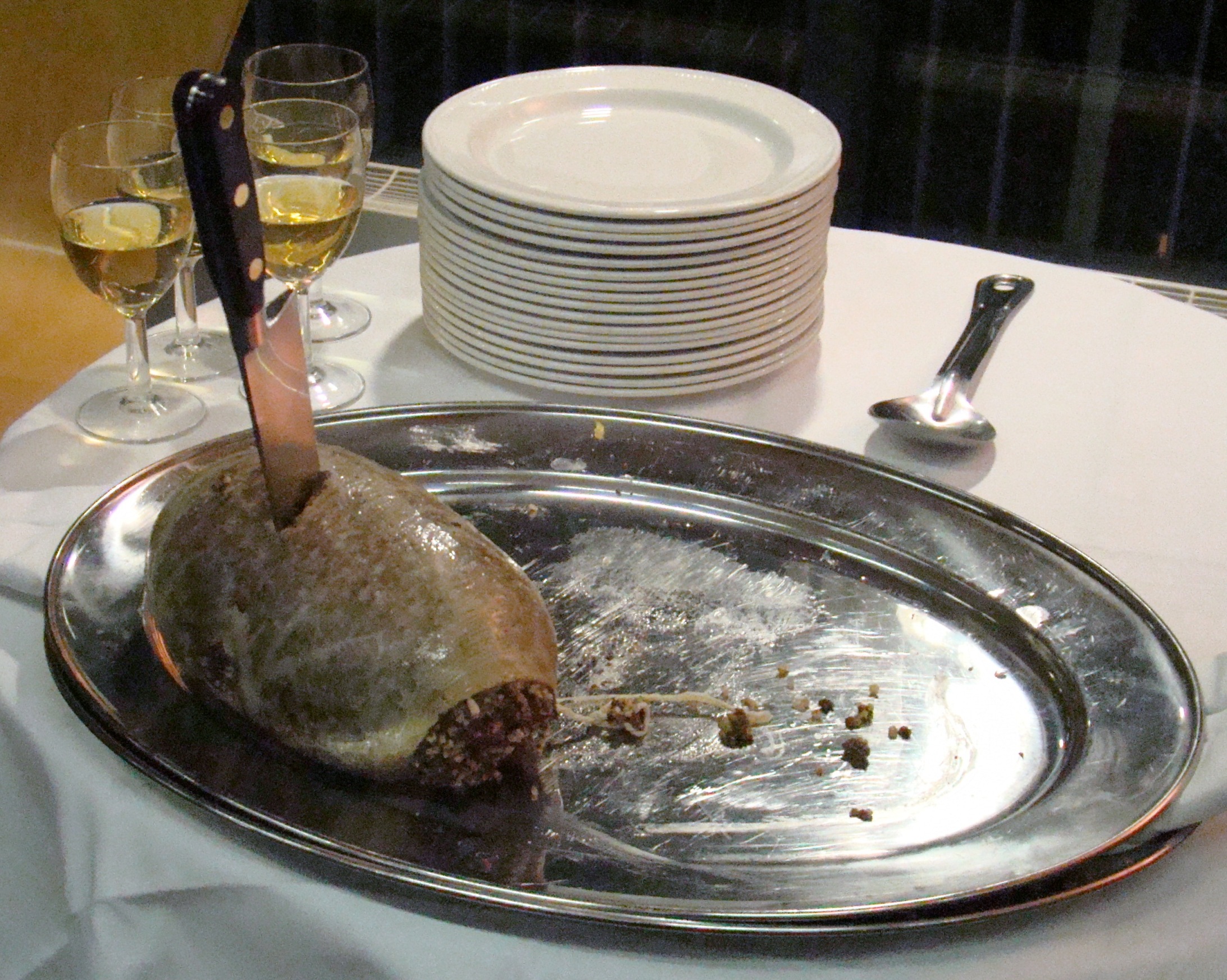|
Kaszanka
Kaszanka is a traditional blood sausage in Central and Eastern European cuisine. It is made of a mixture of pig's blood, pork offal (commonly liver), and buckwheat ( kasha) or barley stuffed in a pig intestine. It is usually flavored with onion, black pepper, and marjoram. The dish likely originated in Germany or Denmark. Kaszanka may be eaten cold, but traditionally it is either grilled or fried with onions and then served with potato and sauerkraut. Other names and similar dishes * ''крывянка'' (''Kryvianka'', Belarus) * ''verivorst'' (Estonia) * ''kaszanka'' (Poland) * '' Kiszka'' (Yiddish קישקע ''kishke'', some districts of Poland) * ''Grützwurst'' (Germany and sometimes Silesia) * '' Knipp'' (Lower Saxony, Germany) * ''Göttwust''; ''Grüttwust'' (Northern Germany) * ''krupńok''; ''krupniok'' (more of a slight name difference than variation; Silesia) * ''żymlok'' (a variation of ''Krupniok'' based on cut bread roll instead of buckwheat; Silesia) * '' Pin ... [...More Info...] [...Related Items...] OR: [Wikipedia] [Google] [Baidu] |
Kishka (food)
Kishka or kishke (Belarusian language, Belarusian: кішка, ''kishka'' ; Czech language, Czech: ''jelito'' ; Slovak language, Slovak: ''krvavnica'' (regionally also ''hurka''); ; Romanian language, Romanian: ''chişcă''; Yiddish language, Yiddish: קישקע : kishke; Hebrew language, Hebrew קישקע; Russian language, Russian: ''кишка'' ; Ukrainian language, Ukrainian: ''кишка'' ; also ; Lithuanian language, Lithuanian: ''vėdarai''; Hungarian language, Hungarian: ''hurka'' ) refers to various types of sausage or stuffed intestine with a filling made from a combination of meat and meal, often grain or potato. The dish is popular across Eastern Europe as well as with immigrant communities from those areas. It is also eaten by Ashkenazi Jews who prepare their version according to kashrut dietary laws. The name is Slavic languages, Slavic in origin, and literally means "gut" or "intestine". It may be related to the Ancient Greek word κύστις (kystis), "bladder ... [...More Info...] [...Related Items...] OR: [Wikipedia] [Google] [Baidu] |
Offal
Offal (), also called variety meats, pluck or organ meats, is the internal organ (anatomy), organs of a butchered animal. Offal may also refer to the by-products of Milling (grinding), milled grains, such as corn or wheat. Some cultures strongly consider offal consumption to be taboo, while others use it as part of their everyday food, such as lunch meats, or, in many instances, as Delicacy, delicacies. Certain offal dishes—including ''foie gras'' and ''pâté''—are often regarded as gourmet food in the culinary arts. Others remain part of traditional regional cuisine and are consumed especially during holidays; some examples are sweetbread, Jewish chopped liver, Scottish haggis, U.S. chitterlings, and Mexican Menudo (soup), menudo. On the other hand, intestines are traditionally used as casing for sausages. Depending on the context, ''offal'' may refer only to those parts of an animal carcass discarded after butchering or skinning; offal not used directly for human or anim ... [...More Info...] [...Related Items...] OR: [Wikipedia] [Google] [Baidu] |
Kasha
In English, kasha usually refers to the pseudocereal buckwheat or its culinary preparations. In Slavic languages, "kasha" means porridge or puree. In some varieties of Eastern European cuisine, ''kasha'' can apply to any kind of cooked grain. It can be baked but most often is boiled, either in water or milk, but the word can also refer to the grain before preparation, which corresponds to the definition of ' groats'. The word "kasha" is used in Belarus (), the Czech Republic (), Lithuania (), Poland (), Romania and Moldova (), Russia (), Slovakia (), Slovenia (), Kazakhstan, and Ukraine (). The English-language usage of kasha, which refers primarily to buckwheat, probably originated with Jewish immigrants, as did the form ''kashi'' (literally translated as "porridges"). In Ashkenazi Jewish culture As an Ashkenazi-Jewish comfort food, kasha is often served with onions and brown gravy on top of farfalle, known as kasha varnishkes. Kasha is a popular filling for knishes and ... [...More Info...] [...Related Items...] OR: [Wikipedia] [Google] [Baidu] |
Pinkel
Pinkel is a smoked Kaszanka (), which is a type of sausage. It is eaten mainly in northwest Germany, especially the region around Oldenburg, Bremen and Osnabrück as well as in East Frisia and Friesland. Etymology The word ''pinkel'' is East Frisian. The sausage name is thought to derive from '' pinkelt'', meaning "little finger". Alternatively, the name could refer to the homonymous verb which means "to drip", referring to the manner in which fat drips from the sausage during smoking. Ingredients and uses Pinkel consists mainly of bacon, groats of oats or barley, beef suet, pig lard, onions, salt, pepper and other spices. The exact composition of the recipe is guarded by butchers as a trade secret and therefore varies from village to village. Pinkel with a high meat content is also described as ''Fleisch-Pinkel'' ("meat pinkel") or ''Oldenburger Pinkel''. Pinkel is traditionally filled into the edible small intestines of pigs, although today edible artificial casings ... [...More Info...] [...Related Items...] OR: [Wikipedia] [Google] [Baidu] |
Silesian Cuisine
Silesian cuisine belongs to the region of Silesia in Central Europe. It is a subtype of Polish and German cuisine with many similarities to and signs of the influence of neighbouring cuisines. The cuisine is particularly renowned for its poppy seed and knödel dishes. List of Silesian dishes * ''Żymła'' - a well-baked bread roll, oval with a division in the middle, topped with poppy seeds, similar to Austrian ''Kaisersemmel''. * '' Kluski śląskie/Schlesische Kartoffelklöße'' (Silesian dumplings) - round dumplings served with gravy, made of mashed boiled potatoes, finely grated raw potatoes, an egg, grated onion, wheat flour, and potato flour * ''Schlesisches Himmelreich''/''Sylezyjske Niebo'' ("Silesian Heaven") - a dish of smoked pork cooked in water with dried fruit and spices * '' Rolada z modrą kapustą'' (rouladen with red cabbage) - best-quality beef-meat roll; stuffed with pickled vegetable, ham, and good amount of seasoning; always served with red cabbage (with f ... [...More Info...] [...Related Items...] OR: [Wikipedia] [Google] [Baidu] |
Ryynimakkara
Ryynimakkara () is a type of sausage in Finnish cuisine containing Groat (grain), groats. Ryynimakkara has barley groats, about one fifth of its weight, lowering its meat and fat content. Also, the fat content is considerably lower than other sausages, usually between 10 and 15%. In some traditional recipes ryynimakkaras are prepared with no meat at all. The closest relatives to the ryynimakkara are the potato sausage (''perunamakkara'') from the Tavastia (historical province), Häme region of Finland, which has potato instead of the barley groats, blood sausages (''verimakkara'') and the black sausage (''mustamakkara'') from Tampere. The use of groats in the ryynimakkara is similar to the United Kingdom, British black pudding although its appearance is different, being a thick and small sausage. Also, the Scotland, Scottish traditional food haggis have some similarities to ryynimakkara, although instead of intestines it is made in the stomach of a sheep. See also *Kaszanka Ref ... [...More Info...] [...Related Items...] OR: [Wikipedia] [Google] [Baidu] |
Central And Eastern Europe
Central and Eastern Europe is a geopolitical term encompassing the countries in Baltic region, Northeast Europe (primarily the Baltic states, Baltics), Central Europe (primarily the Visegrád Group), Eastern Europe, and Southeast Europe (primarily the Balkans), usually meaning former communist states from the Eastern Bloc and Warsaw Pact in Europe, as well as from former Yugoslavia. Scholarly literature often uses the abbreviations CEE or CEEC for this term. The OECD, Organisation for Economic Co-operation and Development (OECD) also uses the term "Central and Eastern European Countries" (CEECs) for a group comprising some of these countries. This term is sometimes used as an alternative to the term "Eastern Europe," for more neutral grouping. Definitions The term ''CEE'' includes the Eastern Bloc (Warsaw Pact) countries west of the post-World War II border with the former Soviet Union; the independent states in former Yugoslavia (which were not considered part of the Eastern b ... [...More Info...] [...Related Items...] OR: [Wikipedia] [Google] [Baidu] |
Caul Fat
Caul fat, also known as lace fat, omentum, or fat netting, is the thin Biological membrane, membrane which surrounds the organ (anatomy), internal organs of some animals, such as cows, sheep, and pigs, also known as the greater omentum in anatomy textbooks. It is used as a casing (sausage), casing for sausages, roulades, pâtés, and various other meat dishes. Examples of such dishes are Vietnamese cuisine, Vietnamese , Swiss cuisine, Swiss , French cuisine, French , Cypriot cuisine, Cypriot , South Africa, South African , British cuisine, British faggot (food), faggots, Serbian cuisine, Serbian and , and Italian cuisine, Italian . In the traditional Ukrainian cuisine, Ukrainian and Russian cuisine, Russian cuisine, caul fat, known as or , was usually filled with and liver (food), liver, and baked in a clay pot in the Russian oven. The Navajo people of the Southwestern United States wrap sheep intestines around strips of caul fat to make a dish called . Gallery File:Salnyk-gre ... [...More Info...] [...Related Items...] OR: [Wikipedia] [Google] [Baidu] |
Slovak Cuisine
Slovak cuisine varies slightly from region to region across Slovakia. It was influenced by the traditional cuisines, cuisine of its neighbours and it influenced them as well. The origins of traditional Slovak cuisine can be traced to times when the majority of the population lived self-sufficiently in villages, with very limited food imports and exports and with no modern means of food preservation or Food processing, processing. This gave rise to a cuisine heavily dependent on a number of staple foods that could stand the hot summers and cold winters. These included wheat, potatoes, milk and milk products, pork meat, sauerkraut and onion. To a lesser degree beef, poultry, lamb and goat, eggs, a few other local vegetables, fruit and wild mushrooms were traditionally eaten. All these were usually produced and processed by families themselves with some local trade at the country markets. Wheat was ground, and bread, dumplings and noodles were made from it. Potatoes were mostly boi ... [...More Info...] [...Related Items...] OR: [Wikipedia] [Google] [Baidu] |
Saumagen
Saumagen (, "pig, sow's stomach") is a Cuisine of Germany, German dish popular in the Palatinate region, Palatinate. The dish is similar to a sausage in that it consists of a stuffed casing; however, the stomach itself is integral to the dish. It is not as thin as a typical sausage casing (intestines or artificial casing). Rather it is meat-like, being a strong muscular organ, and when the dish is finished by being pan-fried or roasted in the oven, it becomes crisp. Stuffing Saumagen stuffing consists of potatoes and pork, usually spiced with onions, marjoram, nutmeg and Black pepper#White pepper, white pepper; various recipes also mention cloves, coriander, thyme, garlic, bay leaf, cardamom, basil, caraway, allspice, and parsley. Sometimes beef is also used; a variant popular in autumn replaces some or all of the potatoes with chestnuts. The larger ingredients are diced finely. After that, the saumagen is cooked in hot water, slightly below boiling temperature to prevent rupture ... [...More Info...] [...Related Items...] OR: [Wikipedia] [Google] [Baidu] |
Haggis
Haggis ( ) is a savoury pudding containing sheep's offal, pluck (heart, liver, and lungs), Mincing, minced with chopped onion, oatmeal, suet, spices, and salt, mixed with Stock (food), stock, and cooked while traditionally encased in the animal's stomach though now an artificial sausage casing, casing is often used instead. According to the 2001 English edition of the ''Larousse Gastronomique'': "Although its description is not immediately appealing, haggis has an excellent nutty texture and delicious savoury flavour". It is believed that food similar to haggis — perishable offal quickly cooked inside an animal's stomach, all conveniently available after a hunt — was eaten from ancient times. Although the name "hagws" or "hagese" was first recorded in England c. 1430, the dish is considered traditionally of Scottish origin. It is even the national dish as a result of Scots poet Robert Burns' poem "Address to a Haggis" of 1786. Haggis is traditionally served with "rutabaga, ... [...More Info...] [...Related Items...] OR: [Wikipedia] [Google] [Baidu] |
Black Pudding
Black pudding is a distinct national type of blood sausage originating in the United Kingdom and Ireland. It is made from pork or occasionally beef Blood as food, blood, with Lard, pork fat or Suet, beef suet, and a cereal, usually oatmeal, oat groats, or barley groats. The high proportion of cereal, along with the use of certain herbs such as Mentha pulegium, pennyroyal, serves to distinguish black pudding from blood sausages eaten in other parts of the world.Jaine, T. and Davidson, A. ''The Oxford companion to food'', OUP, 2006, p.104 Etymology The word ''wikt:pudding, pudding'' is believed to derive from the French , originally from the Latin , meaning "small sausage". History and recipes Blood puddings are often considered to be one of the oldest forms of sausage. Animals are generally bled at slaughter, and as blood rapidly spoils unless prepared in some way, making a pudding with it is one of the easiest ways of ensuring it does not go to waste. While the majority of mode ... [...More Info...] [...Related Items...] OR: [Wikipedia] [Google] [Baidu] |







